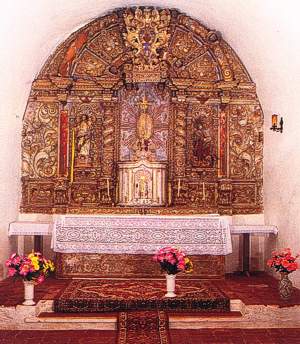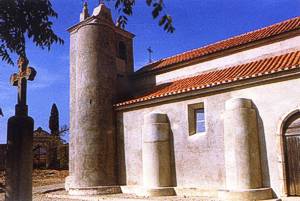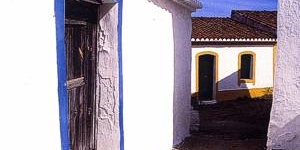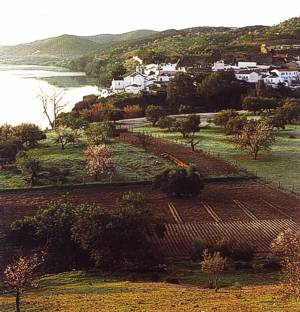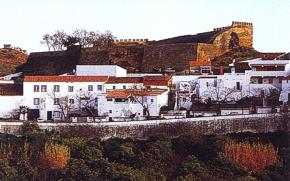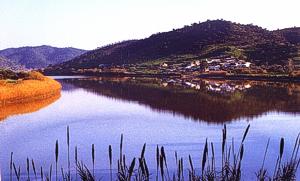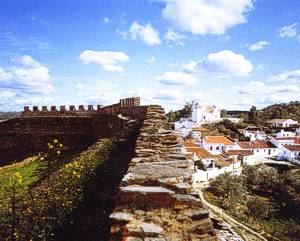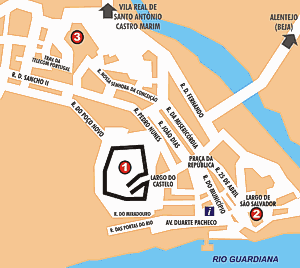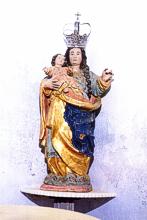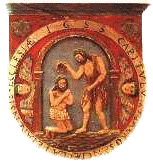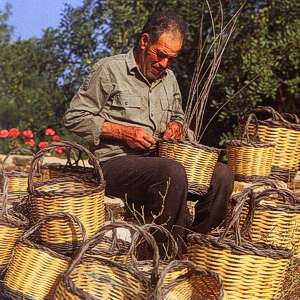|
Tourism |
|
| |
|
| History | Places of Interest | The City | Handicrafts | Lodging Algarve | |
|
The blue river framed by cool greens of the riverside vegetation, of fertile orchards and gardens. The dark ochre of the hills, flecked with colour by cistus plants, holm, oak and the occasional olive tree. Houses with walls of schist or baked mud white with the dazzle of lime, huddled together in hamlets lost among the hills. Such contrasts are to be found in the Alcoutim municipality. |
|
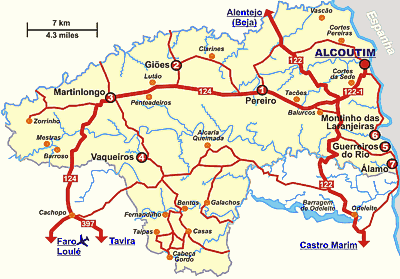 |
| History |
|
|
| Places of Interest |
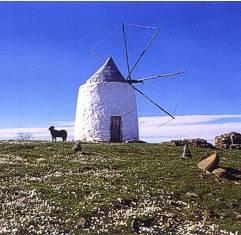 |
|
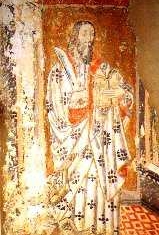 |
|
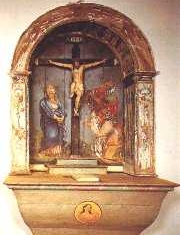 |
| Following the Guardiana |
|
There is a road that winds along the bank of the
Guadiana from Alcoutim as far Alamo. Its route leads it through a
landscape of harsh beauty softened by water, foliage and flowers.
But the best way to discover the river's many delights is by boat.
In Alcoutim Guerreiros do Rio it is possible to hire
boats that can be taken either up or down Guadiana. Upstream from
Alcoutim, watch out for the curious Rocha dos Livros (Rock of Books),
a rock that looks like a shelf carved from stone, and the llha d'El
Rei island. Downstream, the river follows an enchanting course around
long, gentle curves dotted with the white houses of riverside villages. |
|
|
|
|
|
|
|
|
| Visiting the City of Alcoutim |
| The blue ribbon of the river winding between rounded mountains covered with cistus plants. The white stain of houses rising up the slopes of hills which form an amphitheatre crowned with the belfries of churches and the sombre bulk of a formidable castle. The elegant silhouette of sailing boats anchored along the shore. Impressions of Alcoutim that cannot fail to charm visitors, inviting them to wander its streets or while away a peaceful hour or two on an esplanade by the water's edge. |
|
Historical centre |
|
|
|
|
|
|
|
the characteristic emblem of interwoven holm oak branches and the
inscription "Aleo" associated with the raising of the Moorish
siege of the recently conquered city of Ceuta by Pedro de Meneses.
Inside there are three naves, with pillars decorated with attractive
capitals. There is a main chapel and side chapels with carved retables.
There is an interesting collection of sculpted figures. In the sacristy
there are three ogival fanlights. |
|
|
|
|
| Handicrafts |
|
The ancient techniques of popular crafts are still preserved in the villa of Alcoutim, where the locals continue to weave rag blankets, covers and linen cloths on wooden looms (Clarines, Penteadeiros, Mestra Barroso, Vaqueiros) and where the women make shawls, stockings, straw hats and lace (Vascão, Cortes Pereira, Zorrinho, Lutão, Tacões, Vaqueira, Fernandilho, Cachopo). Craftsmen in Balurcos, Cortes de Seda, Clarines, Azinhal, Ferrarias, Galaxinhos, São Lucas and Alcaria Queimada make baskets from the reeds that grow on the banks of the Guadiana river and creeks. The mules and donkeys that work the fields are shod by smiths in Pereiro, Balurcos and Vaqueiros, while hoes, scythes and other tools connected with agriculture are produced in Corte Serranos. Also of interest is the work of the saddle makers in Giões and Pereiro who use straw, coarse linen a woollen threads to make coloured collars and other strapping pieces for horses and mules. |
|
|
| History | Places of Interest | The City | Handicrafts | Lodging Algarve | |
| |
|
|
Alcoutim |
|

 Menhirs
and dolmens testify to a human presence at the end of the Neolithic
and beginning of the Chalcolithic (approximately 4000 BC), in the
context of the megalithic culture that covered the whole of what is
now Portugal. It was the deposits of copper, iron and manganese however
that attracted men from about 2500 BC until the time of the Roman
occupation and a number of mines were established. The ores dug from
them were smelted locally, then shipped down the Guadiana river to
the Mediterranean and from there to the four corners of the Empire.
Human occupation continued under the rule first of the Visigoths and
then the Moors (5th-13th centuries), often on the same sites, giving
rise, after the Christian reconquest, to some of the settlements still
to be found in Alcoutim municipality. Alcoutim's origins are presumably
linked to the fact that it is situated at the place where the Guadiana
becomes tidal. The vessels that plied the trade in metals and other
wares were obliged to wait at this spot for hours, until conditions
allowed there to sail down the river. Consequently there was a need
for structures to
Menhirs
and dolmens testify to a human presence at the end of the Neolithic
and beginning of the Chalcolithic (approximately 4000 BC), in the
context of the megalithic culture that covered the whole of what is
now Portugal. It was the deposits of copper, iron and manganese however
that attracted men from about 2500 BC until the time of the Roman
occupation and a number of mines were established. The ores dug from
them were smelted locally, then shipped down the Guadiana river to
the Mediterranean and from there to the four corners of the Empire.
Human occupation continued under the rule first of the Visigoths and
then the Moors (5th-13th centuries), often on the same sites, giving
rise, after the Christian reconquest, to some of the settlements still
to be found in Alcoutim municipality. Alcoutim's origins are presumably
linked to the fact that it is situated at the place where the Guadiana
becomes tidal. The vessels that plied the trade in metals and other
wares were obliged to wait at this spot for hours, until conditions
allowed there to sail down the river. Consequently there was a need
for structures to  support
and defend them. Conquered during the reign of King Sancho II, in
1240, the town of Alcoutim was not repopulated until that of King
Dinis, who granted it a charter in 1304 and, in view of its strategic
position in relation to the neighbouring kingdom of Castile, granted
it to the Military Order of Sant'Iago (St. James). At the time of
the wars between Portugal and Castile in the 14th century, a peace
treaty between kings Fernando I and Henrique was signed in the middle
of the river, opposite Alcoutim. There followed centuries of peace,
interrupted only by the War of the Restoration (1640-1668) and, in
the first half of the 19th century, by the struggle between liberals
and defenders of the absolutist monarchy, when the fearless guerrilla
leader Remexido hid with his forces in the hills of Alcoutim and the
surrounding region. The decline of the mining industry, the difficulty
of raising crops on the area's poor soils, the town's distance, from
the coast and the Guadiana river's diminishing importance as a transport
route all led to a lengthy period of economic stagnation for Alcoutim
and its municipality that has only gradually been reversed in recent
decades.
support
and defend them. Conquered during the reign of King Sancho II, in
1240, the town of Alcoutim was not repopulated until that of King
Dinis, who granted it a charter in 1304 and, in view of its strategic
position in relation to the neighbouring kingdom of Castile, granted
it to the Military Order of Sant'Iago (St. James). At the time of
the wars between Portugal and Castile in the 14th century, a peace
treaty between kings Fernando I and Henrique was signed in the middle
of the river, opposite Alcoutim. There followed centuries of peace,
interrupted only by the War of the Restoration (1640-1668) and, in
the first half of the 19th century, by the struggle between liberals
and defenders of the absolutist monarchy, when the fearless guerrilla
leader Remexido hid with his forces in the hills of Alcoutim and the
surrounding region. The decline of the mining industry, the difficulty
of raising crops on the area's poor soils, the town's distance, from
the coast and the Guadiana river's diminishing importance as a transport
route all led to a lengthy period of economic stagnation for Alcoutim
and its municipality that has only gradually been reversed in recent
decades.